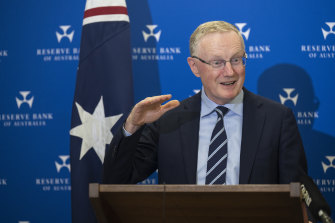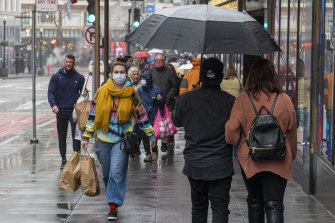
Recession alarm bells are ringing as the war on inflation escalates
June 23, 2022This week produced clear warnings from the Reserve Bank and the US Federal Reserve Board that they will do whatever it takes to bring out-of-control inflation rates under control, even if that means provoking recessions.
On Tuesday, the RBA’s Philip Lowe said the bank was committed to “doing what is necessary” to ensure that Australian inflation – which is running at around 5.2 per cent and which he thinks will top out around 7 per cent in the December quarter – returns to the RBA’s target range of two to three per cent.
RBA governor Phil Lowe will leave no stone unturned as he fights to bring down Australia’s inflation rate.Credit:Louie Douvis
On Wednesday in the US, the Fed’s chair, Jerome Powell, said a recession in the US, where the inflation rate is 8.6 per cent, was possible and orchestrating a soft landing for the US economy was “very challenging.“
“The other risk, though, is that we would not manage to restore price stability and that we would allow this high inflation to get entrenched in the economy. We can’t fail on this task. We have to get back to two per cent inflation.“
While he said the Fed wasn’t trying to provoke a recession, and doesn’t believe it will need to, it was “certainly a possibility”.
When Lowe said the RBA would do what is necessary to return the Australian inflation rate to within its targeted range, he was effectively saying it will keep raising interest rates until inflation and expectations of inflation have been choked off.
He also made a very direct link between inflation and wages, saying wage increases of 3.5 per cent were sustainable but increases should not “mechanically” match the inflation rate and set off the type of wages-prices-interest rate spiral experienced in the 1970s.
The Fair Work Commission, of course, recently awarded a 5.2 per cent increase in the minimum wage and a 4.6 per cent rise for workers on awards. The new Labor federal government supported those increases and there have been calls from the union movement and from within the government for future wage increases in line with the inflation rate.
What Lowe was effectively warning was that, should there be a wages breakout, the RBA will be forced to raise the cash rate by more than it otherwise would and more than take back, in real terms, those increases in income.
Both Lowe and Powell are signalling a fundamental shift in monetary policies. From trying to balance inflation and labour market outcomes they now have a singular focus on inflation, accepting that will slow their economies and almost certainly lead to increases in unemployment and reductions in real wages.
The US is bracing for a recession.Credit:Bloomberg
With America’s inflation rate its highest in 40 years and Australia’s the highest since the introduction of the GST in 2000, the central bankers have no option but to tighten their monetary policies aggressively.
They won’t want to push their economies into recession but monetary policies are crude tools, incapable to being deployed against two objectives at once. It is very clear that, with their peers elsewhere, the RBA and Fed are now focused squarely on inflation even if that means less growth and higher unemployment.
Former New York Fed president, Bill Dudley, writing for Bloomberg this week, said a recession in the US within the next 12 to 18 months was inevitable because the focus on inflation would be “relentless,” with Powell desperate to avoid the mistakes of the late 1960s and 1970s when inflation was rampant and ultimately forced the Fed into a very harsh response and the US economy into a severe recession.
Australia experienced something similar in the early 1990s, with Paul Keating’s “recession Australia had to have.”
The challenge for the RBA and Fed and their peers (Europe is also experiencing high levels of inflation) is that there are elements of the surge in global inflation rates that are beyond their control, some of which might fit the label of “transitory” that caused central banker complacency last year even as inflation rates began to surge.
In fact it is difficult to separate the structural and the semi-permanent influences from the transitory because it was the pandemic, the responses to it by the central banks and their governments and its impact on global economic activity and the supply chains that support it that ignited inflation after decades of dormancy.
Some of those factors could be transitory, like the disruption to global supply chains, but even though there are some positive signs the transition might still be longer than currently hoped and continue to feed into the shortages of products and increases in their prices that is best illustrated by the waiting times and rapidly rising prices for new cars.
The pandemic and the lockdowns, travel restrictions and changes in attitudes to work it induced is also reflected in continuing to be reflected in tight labour markets, with companies struggling to attract workers and wages and salaries rising as a consequence.
China’s zero-COVID policy, even though it has softened recently, is also having an impact on the availability of a vast array of consumer and industrial goods even as consumer demand, globally, has rebounded sharply.
If the RBA and Fed can manage to bring inflation rates back into their target ranges without forcing their economies into recession their efforts would be masterpieces of central banking.
In response to the pandemic governments in the major economies flooded their economies with generous support programs and broader fiscal stimulus, adding to the ultra-loosed monetary policies and the ultra-low interest rates and cost of credit and leaving consumers awash with record levels of savings.
Then Russia invaded Ukraine and was sanctioned by the West and energy and food prices exploded.
Given the propensity of COVID-19 to evolve, it can’t be taken for granted that the pandemic is behind us or, with China committed to its response to outbreaks, that supply chains will function more normally any time soon.
The war in Ukraine could go on for quite some time. In the meantime, Ukraine’s capacity to supply grains and fertilisers to the world market is being severely diminished and Russia’s oil industry is being degraded by the sanctions and the cutting off of access to Western technology and expertise.
Oil prices have fallen back from their levels a fortnight ago – they’ve fallen from about $US124 a barrel to around $US111 a barrel — which could help ease some of the inflationary pressures but the reason for the fall is telling.
The oil market is pricing in lower demand because traders are starting to price in the prospect of recessions and reduced demand.
Central banking is as much art as science. If the RBA and Fed can manage to bring inflation rates back into their target ranges without forcing their economies into recession their efforts would be masterpieces of central banking.
The Business Briefing newsletter delivers major stories, exclusive coverage and expert opinion. Sign up to get it every weekday morning.
Most Viewed in Business
From our partners
Source: Read Full Article




